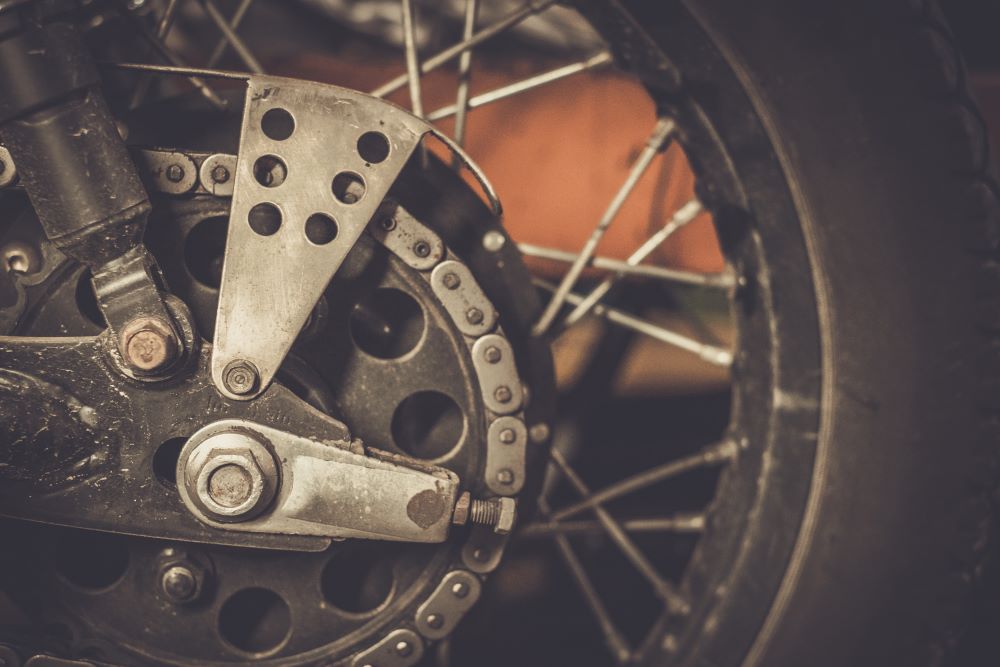What is a Timing Chain in Motorcycle and How it Works?

A vehicle works with the help of proper coordination between multiple components. One such component is a timing chain, which is essential to synchronise the rotation between the camshaft and the crankshaft.
Curious to learn more about a timing chain?
Scroll down to know more about a timing chain and its significance in the automotive sector.
What Is a Timing Chain?
A vehicle's engine is a major component that allows it to move. Here, among others, the camshaft and the crankshaft are important elements. Located in the lower and higher portions of an engine, these two elements are essential for driving the wheels of a vehicle.
A timing chain plays a part in synchronising the rotation and movement of these two elements. The movement of a motorcycle timing chain allows the engine cylinders to produce power. The inlet and outflow valves of the engine open and close with the movement of this chain.
How Does a Timing Chain Work?
Here’s how a timing chain works:
The main role of a timing chain set is to synchronise the opening and closing of the engine valves, which are the intake and exhaust valves.
With the help of a timing chain, these valves move in sync and at the right intervals, which allows a sufficient amount of fuel to enter an engine. It also ensures that the exhaust exits the engine.
A timing chain requires the exact amount of internal combustion to take place within a vehicle. This should depend on a driver's desired speed.
It links the upper part that are cylinder head and valves and the lower part that are pistons and crankcase of the engine, ensuring overall engine performance and optimal power within a vehicle.
How Often Does a Timing Chain Need to be Replaced?
Multiple factors determine the replacement timeframe of a timing chain. Thus, a vehicle's mileage can cause more wear to this chain than its age. The expected range of such a chain is about 60,000 to 100,000 miles. After this, it must be replaced.
However, you need to consult your vehicle's manual for more details.
What Are the Symptoms of a Failing Timing Chain?
Ensuring regular timing chain replacement for properly functioning a vehicle's engine is important. For this, one needs to be able to identify the symptoms of a failing or damaging timing chain. Here are some of these:
- Rattling Noise: There will be noises in the engine once its timing chain starts to loosen. A loose chain will rattle and clang about within the engine, causing this noise. This sound indicates a problem in the chain.
- Misfiring Engine: Once a timing chain is worn out, the calibration of this chain will turn off. This serious situation can cause misfiring and sluggishness in its engine.
- Metal in Engine Oil: If a timing chain is damaged and fatigued, metal from the chains gets flaked and mixed in the oil. When changing this oil, you will find pieces of metal in it. This again indicates a problem with a chain.
- Check Engine Light: Sensors of a vehicle usually identify issues with the engine and its components. If the check engine light of a vehicle starts glowing, it means there can be problems with its timing chain.
- Vehicle Issues: If a timing chain is not working properly, you will face trouble starting your vehicle or the engine. Moreover, you may experience vibration in your vehicle’s engine if it starts idling.
What Is the Difference Between a Timing Chain and a Timing Belt?
Now that you know the process of working on a timing chain, it can be confusing to differentiate between a timing chain and a timing belt. Here are a few differences between the two to help you understand this concept further:
|
Criteria |
Timing Belt |
Timing Chain |
|
Appearance |
It is a closed belt used in an engine, mainly made of rubber. |
As the name suggests, it is an actual metal chain connected to the engine. |
|
Composition |
This belt works with the help of a series of pulleys. There is no requirement for oil lubrication here. |
Timing chain tensioners controlled by oil pressure are used for holding the chain in place. |
|
Location |
This belt sits right outside the engine in a vehicle. It can stay outside as it does not require lubrication. |
It requires oil lubrication and is thus located inside an engine. This way, it receives the engine oil. |
|
Noise |
Timing belts have much lower noise, as these are made of rubber components. |
Timing chains are made of metals and, therefore, can cause major noise while the engine is working. |
|
Durability |
These have much lower durability. You need to change these if your vehicle has driven about 40,000 miles. |
These have much higher durability, almost as much as a vehicle. You do not need to change it before driving at least 60,000 miles. |
|
Expenses |
These belts are much less expensive than that of a timing chain. |
Chains are more expensive than belts, as they are more durable and made of metals. |
Thus, as you can see, a timing chain and a timing belt are not the same. Even though they have a similar role, there are plenty of differences between the two in terms of appearance and overall performance and efficiency. This causes differences in their prices.
That was our guide to a timing chain and its importance for the efficiency of vehicles. It is an essential component that ensures optimal vehicle power and performance. You must replace it once in a while if it shows signs of damage and fatigue.


















